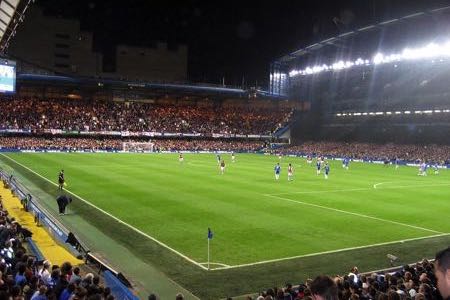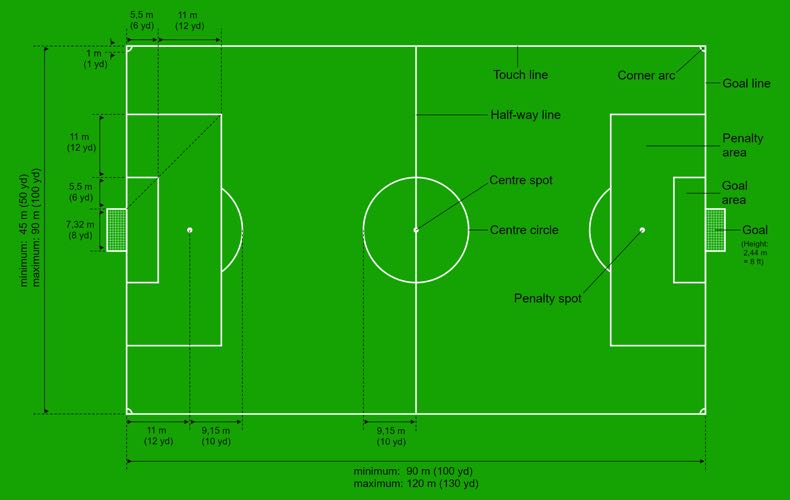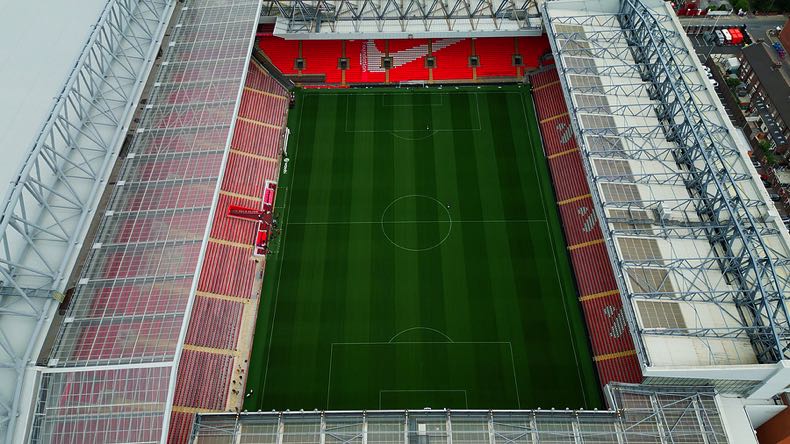
This is not quite a “how long is a piece of string” question, though there is a tiny bit of wiggle room when it comes to how big a full-size football pitch is. Important to note here is that football pitches can vary in their exact measurements, but there is a size range that they must fit into.
There are some myths attached to football pitch sizes too. Many a fan, commentator and ex-player would talk in the past about the ‘big pitches’ at places like Wembley or the Nou Camp. In reality, however, it was all about camera angles and high commentary positions. For those of us who have stood at the side of the Nou Camp, it’s clear that the pitch looks as small and compact as any other at ground level.
Official Football Pitch Dimensions

Some parts of an 11-a-side football pitch cannot change in size. The penalty box is 44 yards wide and 18 yards deep, hence it is known as the ’18-yard box’. There is the 6-yard line (self-explanatory) and the penalty spot, which is always 12 yards from the goal line.
The corner arc is one yard from the flag and the centre circle is ten yards from the centre spot. These measurements don’t change, but the overall length and width of a pitch can and does change from stadium to stadium. The FA publishes recommended minimum pitch sizes for senior 11v11 games. They are:
- 101 metres long by 64 metres wide
- 110 yards by 70 yards wide
This makes the total area of the pitch some 69,300 square feet, or 1.6 acres for a full-size football pitch. This area doesn’t include any run-off area, which the FA recommends is at least 6 yards. That gives the assistant referees room to manoeuvre, as well as providing safety for players who often leave the pitch due to sliding/tackling etc. Goals are left as standard, being measured at 8ft high and 24ft wide.
Current Major Pitch Sizes

To show how much pitch sizes vary versus the recommended dimensions, here are the pitch sizes given for various British stadia:
| Stadium | City | Opened | Last Renovation | Pitch Size |
|---|---|---|---|---|
| Ibrox | Glasgow | 1899 | 1991 | 115y x 74y |
| Brentford Community Stadium | London | 2020 | – | 115y x 71y |
| Stamford Bridge | London | 1877 | 1998 | 112y x 73y |
| Selhurst Park | London | 1924 | 2014 | 109y x 73y |
| Craven Cottage | London | 1896 | 2023 | 109y x 71y |
| Anfield | Liverpool | 1884 | 2023 | 110y x 74y |
The ideal modern standard is 115 yards by 74 yards. That is the case with the stadiums at Rangers, Newcastle, Man City, Aston Villa and many others. It is also the size of the pitch at Wembley Stadium. Some football grounds simply cannot accommodate these measurements however, meaning there is a size difference for managers and players to take into account when coming up with a game plan. Depending on the camera angle at a given stadium, we watching from home may not notice it.
Does Pitch Size Impact on the Game for Viewers?

While even a 5-yard length difference can make a difference to players, those watching tend not to be affected. If there is a difference at all, however, for those attending matches, then the smaller the pitch, the better. There is a notoriously flat atmosphere at certain sporting events when crowds cannot be close enough to the action, even within a stadium. In athletics, the width of the track and other surfaces keeps the crowd far enough away as to not feel particularly close to the competitors.
Compare that with tennis, a sport which feels like a very intimate affair, and it seems the size of the playing surface counts for plenty when it comes to atmosphere. To create a great football atmosphere, the pitch shouldn’t be too large and the crowd should be as close to the playing surface as possible. Tiers are ideal for this purpose. If a stand goes too far back, then only those in the lower sections are close to the action while those at the top move further away not only in height, but in overall distance.
There is a great myth for example about one-tier stands. The famous ‘Yellow Wall’ at Borussia Dortmund and the stand at the new Tottenham Hotspur Stadium in fact don’t create a great atmosphere. In Dortmund’s case, they squeeze around 20,000 fans in there at approximately €10 – €20 per ticket, allowing standing too. This means a certain ‘type’ of football fan being able to attend. They are noisy and vociferous and this is what creates the atmosphere, not the shape of the stand.
There is also the matter of Dortmund and Tottenham being big players in their respective leagues, perhaps skewing the figures when it comes to home success which some attribute to the ‘atmosphere’ created in such stands. In fact, those at the back of the Yellow Wall or at Spurs are too far away to have any real impact on the pitch-side atmosphere. If you were to take the Bernabeu as it was, or some of the American football stadiums, they don’t look as big from the outside as you’d expect.
They are tiered however, meaning the attendees at the top of each stand are not far away and are almost right on top of the action, looking down. This makes for a very intimidating atmosphere for visiting players, with a smaller pitch also meaning a crowd as big as 80,000 can feel as though they are all right on top of the action.
